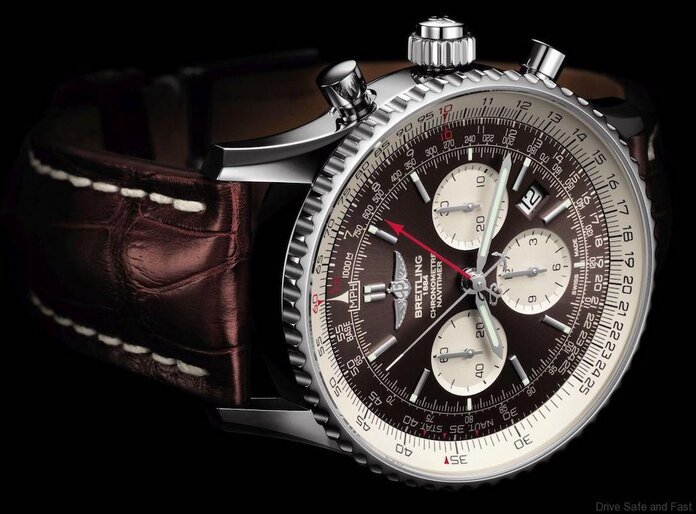Breitling, the market leader of professional chronographs for pilots and professionals, now presents its own split-seconds chronograph movement, also known as Rattrapante. The new, innovatively constructed Caliber B03, like the other movements developed by the Swiss manufacture, ensures extreme precision, sturdiness and reliability. Protected by two patents, this highly technical complication comes alive under the brand’s popular Navitimer. Initially two models are being released: in steel or gold with an exclusive bronze-colored dial.
With its two superimposed central chronograph hands, of which one can be stopped so as to measure an intermediate (split) time, before “catching up” (rattraper in French) with the first one still sweeping onwards, the split-seconds chronograph is considered one of the hardest horology mechanisms to create. That is why this “Grand Complication” is generally produced in small series and requires watchmakers to perform a lengthy process of adjustment and rating. In developing its own split-seconds chronograph movement, Breitling has adopted an innovative approach to this exceptional mechanism. True to its philosophy of “instruments for professionals”, the specialist of technical watches has opted to focus on sturdiness, precision and reliability as applied to large-scale production.
The major challenge for the developers of a split-seconds chronograph movement relates to the level of energy. The constant stopping and starting of the split-seconds hand results in variable energy requirements that can prove detrimental to chronometric precision and reduce a watch’s power reserve. One of the means of resolving this issue consists in equipping the movement with an isolating system serving to disconnect the split-seconds hand when it is stopped. This was the approach chosen by Breitling. However, the brand engineers and watchmakers revisited the construction of the split-seconds mechanism in order to achieve a more reliable and effective solution. They therefore developed two innovations for which patents have been filed. The first breakthrough relates to the isolating system. The component driving the split-seconds lever normally takes the form of a cylindrical pin: an organ that is complex to produce below a certain diameter. Breitling has replaced this pin by a stamped part enabling it to achieve a more precisely defined shape, as well as enhanced sturdiness. Thanks to this isolating system, the use of the splitseconds hand has no impact on the precision of the timing, nor on the power reserve.
The second innovation concerns the mechanism for stopping the split-seconds hand. Watchmakers traditionally use a wheel (either smooth or with extremely fine toothing) that is clamped in place. This system is complicated to produce and can lead to a certain degree of inaccuracy. Inspired by cycle brakes equipped with rubber pads, Breitling’s engineers had the idea of surrounding the wheel with an O-ring seal that would be compressed by the clamp. This results in extremely precise stopping and a system that is simpler to produce and thus more reliable.
In developing its selfwinding split-seconds chronograph Caliber B03, Breitling worked on the basis of its Manufacture Breitling Caliber 01, an intelligent platform that has already enabled the addition of other useful functions such as second timezone or worldtime displays featuring unprecedented user friendliness. The B03 therefore picks up all the advantages of this high-performance ‘engine’, including a 70-hour power reserve (guaranteeing enhanced rating regularity) as well as an innovative modular-type architecture. The split-seconds mechanism comprises just 28 parts.
Regrouping most of these components in a module fitted between the mainplate and the calendar mechanism not only simplifies production and assembly, but also maintenance – since the watchmaker can remove the module as a single block for any servicing or repairs. Like all Breitling movements, the Manufacture Breitling Caliber B03 is chronometer-certified by the COSC.
To highlight its exceptional new ‘engine’, Breitling has chosen its famous Navitimer, the doyenne of all mechanical chronographs produced worldwide (since 1952). Equipped with a 45 mm case, the Navitimer Rattrapante comes in steel as well as a 250-piece red gold limited edition (equipped with a transparent caseback).
Both watches are distinguished by their exclusive bronze-colored dial, serving as a backdrop for the silver-toned counters and inner bezel reflecting the classic Navitimer look. In an extremely refined detail, the B logo with its anchor symbol generally adorning the base of the Navitimer chronograph hands is in this instance divided between the two seconds hands: with the B on the red chronograph hand and the anchor on the split-seconds hand.
This means the two elements are separated when the split-seconds hand is stopped, before reforming the brand signature when the hands are again overlaid. The split-seconds pusher, housed in the 3 o’clock crown, serves to stop and restart the split-seconds hand as often as desired during a timing operation – in order to measure split times or to compare the results of several competitors.
Technical details
Movement
Manufacture Breitling Caliber B03, officially chronometer-certified by the COSC, selfwinding, high-frequency (28,800 vibrations per hour), 46 jewels
More than 70-hour power reserve
Functions
Split-seconds chronograph, 1/4th of a second; 30-minute and 12-hour totalizers. Calendar
Case
Steel or 18K red gold (250-piece limited series, transparent sapphire crystal caseback)
Water resistance 3 bars
Rotating bezel with circular slide rule
Cambered sapphire crystal, glare-proofed on both sides
Diameter: 45 mm
Dial
Panamerican bronze
Straps/Bracelet
Leather, crocodile, rubber Navitimer/Navitimer (steel only)
